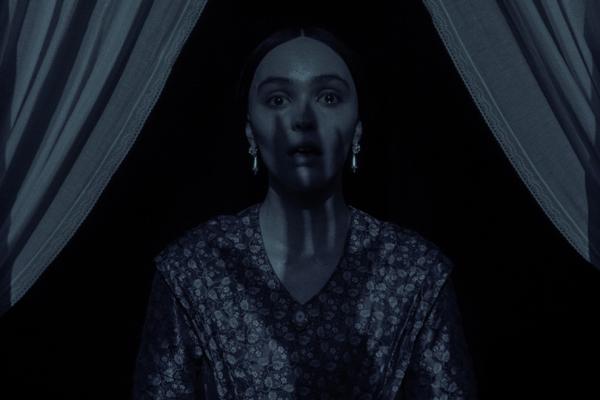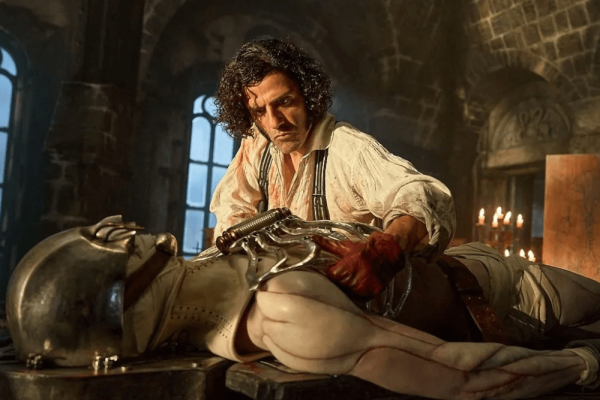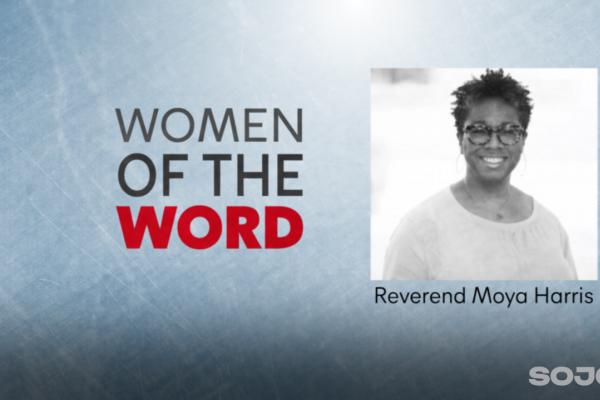This article contains spoilers for the film Nosferatu (2024).
A young woman lies naked on a bed, the white sheets and her pale skin both streaked with blood. A desiccated corpse lays atop her. As the camera pulls back, sunlight streams across the couple revealing flowers covering the ground. The dried-out body is Count Orlok (Bill Skarsgård), the fearsome vampire. The woman is Ellen Hutter (Lily-Rose Depp), and she has given her life to defeat this ancient evil. This final shot of Nosferatu is one of horror, but also, uncomfortably, beauty.
Posing these two in a postcoital embrace, writer-director Robert Eggers seeks to empower Ellen as a martyr: Yes, her death is a tragedy. But by giving her agency in a world that sought to deny her humanity, Ellen is a savior, one who has laid down her life for her loved ones and for the world. The Christian parallels are obvious at first blush — no wonder this film premiered on Christmas. But the martyrdom illuminates the limitations of the liberation achieved by the martyr’s sacrifice.
Veneration of martyrs has a long history in the church, extending back to Jesus, who gave himself up to death as a means to reunite humanity with God — what theologians call atonement. In the decades following Jesus’ death and resurrection, as the way of Jesus spread across Rome, the empire extended increasing hostility upon Jesus followers. By the time John of Patmos wrote his Revelation, at least one Christian in Asia (the Roman province roughly analogous to modern-day Turkey) had been killed explicitly because he refused to renounce Jesus for Caesar.
The possibility of execution became real for many Christians, so they came to understand this particular form of death as something holy: If Rome executed them for bearing witness (which is what “martyr” means in Greek), then they were imitating Jesus to the very end. And so martyrdom became a way for Christians to join Jesus in his death, to participate with him in his work of liberation.
The glamorization of martyrdom
This celebration of martyrs remained a strong thread in Western Christianity for centuries. In 1563, historian John Foxe published a collection of stories of Protestants who suffered persecution from Catholics — a book we know today as Foxe’s Book of Martyrs. The book has been updated at least 15 times, most recently in 1838.
When I was in high school, DC Talk released their Nirvana-clone youthgroup anthem “Jesus Freak,” which they accompanied with a contemporary book of martyrs (called Jesus Freaks). “Jesus Freak” came out the same year Left Behind made its debut; a series that glamorized Christians being martyred by the Antichrist and his minions for 12 whole books before Jesus finally took revenge.
Clearly, I came of age in a faith obsessed with dying for Jesus. There was something almost sensual about the idea of sacrificing my body for the glory of God.
Nineties culture was picking up on something scriptural. In Revelation, martyrs are heroes: John depicts them gathered under the altar of heaven in Revelation 6. God gives them white robes, a sign of vindicated martyrdom. And yet, the earliest Christians didn’t particularly want to die for Jesus. In Revelation 6, the martyrs aren’t glad they died. They demand to know, “Sovereign Lord, holy and true, how long will it be before you judge and avenge our blood on the inhabitants of the earth?” John doesn’t view their deaths as a good thing. Rather, it’s their faithfulness in the face of death that John praises as holy and good. But, like Jesus, they die because they live in a world that is at odds with its Creator, so their faithfulness is linked inextricably to their death. Perhaps it’s inevitable that we end up focusing on their death rather than their faithfulness.
Atonement theories
Two atonement theories clash in this confusion over martyrdom. The early church saw martyrs as imitators of Jesus. John’s gospel (and Revelation) connect Jesus’ execution with the slaughter of the Passover lamb. Just as the Hebrews killed a lamb for protection as they fled enslavement, so Jesus’ death rescues believers from death and empire.
New Testament writers shaped this Passover lamb metaphor into what theologians call the Christus Victor (“Christ the Victor”) theory of atonement: Jesus’ death is the means of conquering the forces of evil. When Jesus appears as a sacrificed lamb in Revelation 5, the divine court responds by singing, “You are worthy… for you were slaughtered and by your blood you ransomed for God saints from every tribe and language and people and nation (5:9).”
When believers remain faithful to Jesus even at the point of death, they join in Jesus’ victory. In Revelation 12, John depicts a voice in heaven celebrating the faithfulness of martyrs as a victory over their accuser: “They have defeated him by the blood of the Lamb and by their testimony. And they did not love their lives so much that they were afraid to die” (Revelation 12:11). Dying as a martyr meant joining in Jesus’ liberation work.
During the Protestant Reformation — a few decades before John Foxe published his book of martyrs — John Calvin and Martin Luther focused more on Jesus as a proxy, or stand-in, for humanity’s sins. This theory, called penal substitution, imagines Jesus as a substitute receiving punishment for us. Since sin offends God’s justice, God must punish us; Jesus took humanity’s place, bearing punishment that should rightfully be ours. It’s not so much that Jesus dies with humanity as for humanity.
Ellen, the Redeemer
These theories agree that Jesus, because of his sinless nature, is uniquely qualified to rescue humanity from death. It’s this purity that clangs in Eggers’ vision. Ellen certainly is a Christ figure — she dies so humanity can live — but it’s not her purity that renders her capable. Rather, it’s her innate feminine power, a power denied by the patriarchal world in which she is trapped.
Eggers’ Nosferatu is a bold remake of what many consider to be the original horror film. F. W. Murnau’s 1922 Nosferatu: A Symphony of Horror introduced a vampire who embodied the terrors of global catastrophe. Eggers’ remake hews remarkably close to Murnau’s original story: Ellen has a mystical (and, in Eggers’ version, explicitly sexual) connection to Orlok, who psychically assaulted her when she was a child. Her husband Thomas (Nicholas Hoult) enables Orlok’s move to Germany, and he works with several friends to defeat Orlok. The alchemist von Franz (Willem DaFoe) knows the men will prove ineffective against Orlok — all their masculine posturing powerless against so great an evil.
So von Franz convinces Ellen that she alone has the key to defeating the monster. He tells her, “I fear Nosferatu is impervious to any of our iron stakes. I’m convinced only you have the faculty to redeem us.” Ellen watches him leave, a black bonnet surrounding her head like a dark halo. Von Franz turns back to her and says, “In heathen times, you might have been a great priestess of Isis. Yet in this strange and modern world, your purpose is of greater worth. You are our salvation.”
Eggers’ version clarifies themes implied in the story of Nosferatu: Ellen is a glorious martyr. Eggers explained to critic Alissa Wilkinson that he wanted to depict Ellen as a woman who, though she was marginalized and harmed by this modern society, found a path to empowerment and liberation. Reflecting on criticisms of the literature of the 19th and early 20th centuries, Eggers says that “in this very repressed Victorian society, over and over again, this archetype that was needing to consummate itself in the patriarchal imagination is a woman who understands the darkness and the sexuality and the earth juju, and should be the savior of the culture.”
Emboldened by von Franz’ challenge, Ellen returns home and gives herself to Orlok, keeping him occupied until the sun rises. As Eggers explained to Wilkinson, it wasn’t Ellen’s purity that defeated Orlok and “it’s not sunlight killing him. It’s the purity of dawn.” Ellen, because of her mystical feminine sensuality — the very opposite of Victorian notions of purity — has the power to bind the insatiable evil in a trap of its own gluttony, helpless to stop even in the face of its own destruction. This is indeed a dark mirror of Jesus’ own sacrifice.
Indeed, it matters to Christian views of atonement that Jesus himself was both innocent and marginalized. And the early church’s veneration of martyrs is evidence that, when the oppressed find themselves powerless before their oppressors, they often have only their bodies to fight back. This is the spirit that empowered Gandhi’s revolt against the British Empire, the Civil Rights Movement in the 1960s U.S., and much of the Black Lives Matter movement. The good news of the atonement is not only that we may die with Jesus, but that Jesus dies with us.
In the face of overwhelming evil, is martyrdom really the best we can hope for? Eggers seems to think so. Such is the import of that final shot: two corpses, lifeless bodies locked in a lovers’ embrace. Two corpses that embody both union and separation.
In Ellen, Eggers created a female character who is both victim (of the vampire and her society) and hero. Christ, at least according to predominant atonement theories, is also a victim-hero. Both Ellen and Jesus are martyrs who gave themselves up for the greater good, purchasing salvation for a world committed to denying their humanities. This is a beautiful sentiment. It’s powerful, in its way.
Revelation 5 announces Jesus as the Lion of Judah, an image that was thrilling for some of those readers suffering under the weight of Roman oppression. But when John turns to see Jesus, he sees not a lion but a slaughtered lamb. What makes Jesus the final source of liberation is not his power over death, but the purity of his faithfulness — a faithfulness that led him to be slaughtered.
This is a powerful message for those facing overwhelming evil. We do not have to meet violence with violence. We don’t need to seek out an esoteric power that will enable us to overmatch the forces of evil. Rather, we can remain faithful to the way of Jesus, confident that the same faith that raised him from death will deliver us as well.
Nosferatu’s vision of liberation ultimately offers up the most vulnerable for the sake of the privileged. It’s a flawed, limited atonement. A liberation that doesn’t liberate those most oppressed cannot be just.
Christian atonement insists that not only do we die with Jesus, but we’re raised with him too. The final goal of faith isn’t locked in death’s embrace. It’s resurrection. Revelation is not a tragedy — it ends not with the funerals of the martyrs but the marriage feast of the Lamb. All the funerals are undone and heaven and earth become one. The martyrs’ faithfulness is rewarded not by being immortalized in a book of stories (or on the silver screen) but with resurrection and vindication. Anything less than that is a true horror.
Got something to say about what you're reading? We value your feedback!







